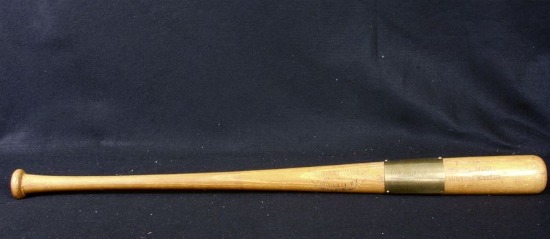The List: Legends Play Ball at the Smithsonian
With the World Series set to start, see some of the all-time baseball greats in the Institution’s collections
/https://tf-cmsv2-smithsonianmag-media.s3.amazonaws.com/filer/20111019121004yaz-batting-helmet-small.jpg)
With the St. Louis Cardinals and Texas Rangers set to play game one of the World Series tonight, the country is abuzz with excitement to see some of the top players perform on the sport’s biggest stage. Get your baseball fix by taking a look at some artifacts from the game’s greatest all-time legends that are now part of the Smithsonian Institution.
1. Jackie Robinson Autographed Ball There is just one number retired by every major league baseball team: #42. Jackie Robinson’s contribution as the first African-American to play in the majors in the modern era transcended the sport, as he became a symbol of the emerging civil rights movement and discredited racial stereotypes with his poise and performance. After winning the first MLB Rookie of the Year award in 1947, his debut season for the Brooklyn Dodgers, he went on to an outstanding career as an infielder, and was named NL MVP in 1947. This ball, autographed by Robinson and other members of the Dodgers during their 1952 pennant-winning season, eventually made its way into the American History Museum‘s collection.
2. Yogi Berra Sculpture Although Yogi is perhaps best-known nowadays for his self-deprecating humor and “Yogi-isms” (“When you come to a fork in the road, take it,” and “It’s déja vu all over again”), during the ’40s, ’50s and ’60s he was consistently the best catcher in the game. After making 15 straight All-Star teams and leading the Yankees to a remarkable ten World Series championships, he embarked on a successful career as a manager, guiding both the Mets and Yankees to the World Series. The National Portrait Gallery‘s bronze sculpture of Berra was cast by Rhonda Sherbell and is on display in the “Champions” exhibition.
3. Stan Musial’s 3000th Hit Bat As his St. Louis Cardinals go for their 11th championship, Stan “the Man” Musial is still known as one of major league baseball’s most consistent, powerful and prolific hitters, 48 years after his retirement. In his first full season, he led the team to a World Series title; the next year, he earned his initial MVP and made the first of his record 24 trips to the All-Star game, all with the same team. On May 13, 1958, with a pinch hit RBI double against the rival Cubs, he became the eighth player to reach the 3000-hit milestone. His storied Louisville Slugger is now at the American History Museum.
4. Sandy Koufax’s Glove With a blazing fastball at the age of 20, Sandy Koufax signed with his hometown Dodgers for a then-remarkable $4,000 bonus. In 1961, after five years of inconsistent performance, he decided to give baseball one last shot and quickly became the most dominant pitcher in the major leagues. He went on to throw four no-hitters, make seven All-Star games and win three triple crowns, but his greatest cultural significance may have come when, as a Jew, he famously declined to pitch game one of the 1965 World Series because it fell on Yom Kippur. Weathering criticism, he came back to play in three of the final six games, posting a shutout victory in the decisive game seven and winning World Series MVP.
5. Carl Yastrzemski’s Batting Helmet: One of the Boston Red Sox’ all-time greats, Yastrzemski was a stellar hitter for both power and average, and won seven Gold Gloves for his work in left field. In 1967, he was the last batter to win the triple crown—leading both leagues in average, home runs, and runs batted in. Although the Sox had finished in 9th place the year before and were considered heavy underdogs, “Yaz” hit with a .513 average over the last two weeks of the season to win the A.L. pennant on the final day of the season. Among Yastrzemski’s quirks was his habit of enlarging the right ear hole and removing part of the right ear flap of his batting helmets, to improve his vision and hearing at the plate, as seen in the circa 1970 helmet in the museum’s collection.
/https://tf-cmsv2-smithsonianmag-media.s3.amazonaws.com/accounts/headshot/joseph-stromberg-240.jpg)

/https://tf-cmsv2-smithsonianmag-media.s3.amazonaws.com/accounts/headshot/joseph-stromberg-240.jpg)